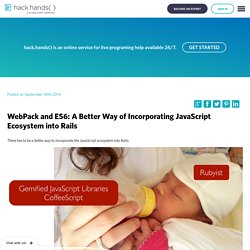

React JS and Flux in Rails, a complete example. I recently wrote about real-world results with React JS.

Here is a concrete example of adding React to a Rails app, start to finish. React JS is a library from Facebook that powers user interfaces. It is simpler, faster, and less opinionated than many JavaScript MVC frameworks, making it easier to bring into an existing app. Start by reviewing our recommended React resources, then check out an example below. The example At Cook Smarts, we want recipes to be consistent, so we provide administrators with suggested ingredient names. Suggestions are populated from previous recipes automatically, but they need to be pruned by an administrator to make sure they’re accurate. The app needs to provide an Excel-like way to quickly prune suggestions. React JS, in under 150 lines of readable code, gets us exactly what we need, an Excel-like data editor. Tooling The example below relies upon Ruby on Rails, the react-rails gem (latest stable version), and Fluxxor (added to the app’s JavaScript manifest).
FancyPixel/small-rails. 3 ways to integrate Ruby on Rails + React + Flux. Why I’m using React with Rails I've been using Rails for years and recently I’ve been integrating javascript frameworks into my stack in various ways to help with front end development.

There are a lot of great javascript frameworks out there like Angular, Ember, Meteor, etc, but my current favorite is React and Flux. Facebook has been doing tremendous work open sourcing their javascript stack from Instagram and Facebook with tools like React, Flux, React Native, and Relay. The details behind all of those are pretty ridiculous, but I encourage you to check all of it out on their YouTube channel and React website. I’m going to focus on Flux and React in this blog, but I’d recommend these videos if you’re interested in learning about React Native and Relay, and They are really exciting libraries that will extend the already awesome React ecosystem.
React is fairly simple to get going with, but there are actually a lot of high level reasons why it is so great. Shakacode/react-webpack-rails-tutorial. Fast Rich Client Rails Development With Webpack and the ES6 Transpiler - Rails on Maui. There has to be a better way to incorporate the JavaScript ecosystem into Rails.

Have you: Wondered if there’s a better way to utilize modern JavaScript client frameworks the context of an existing Ruby on Rails project? Gotten confused about how to integrate JavaScript libraries and examples that are packaged up into proper “modules”? Discovered the drawbacks of having all applications JavaScript littering the global name-space? Heard about ES6 (aka Harmony), the next version of JavaScript and how the cool kids in Silicon Valley (Facebook, Instagram, Square, etc.) are using ES6 syntax? How would you like to achieve the following within a Rails project?
This article will show you how you can utilize Webpack in your Rails development process to achieve these goals! Tutorial, Walkthrough, Guide. In May, I gave a talk on “An Introduction to React, Flux, React-Rails” at NYCDA.

The slides can be found here or you can contact me to arrange to hear the talk again. In this post, I’ll go into more details about the messaging example introduced in the talk and trace how data is passed uni-directionally from the backend down to the view, as is the signature of a React-Flux App. (The example source code is here.) To review, React is a Javascript view library, functioning as the “V” in MVC. It is lightweight and friendly so you could drop it in any framework you’re working with – Rails, Django, or even Angular. The most crucial concepts in React land are “uni-directional data flow” and “Virtual DOM.” The actors here are: 1. the data (model) change event 2. the state & props 3. the components. Alexfedoseev/generator-flux-on-rails. Enaqx/awesome-react. Building robust web apps with React: Part 1, in-browser prototypes.
Whenever I look into the internals of web browsers and the protocols that make the web work I usually end up feeling uneasy.

The number of parts that can and do go wrong makes it incredible that anything we build works at all. The against-all-odds robustness comes from the fault tolerance and backward compatibility engrained into key parts of web stack. The browser will always do its best to output something useful whether it’s parsing a badly authored document, unable to retrieve dependencies or 10 years out of date. I think this fundamental property of the web gets forgotten.
Our aspirations as developers are becoming increasingly aligned with expectations set by other platforms. I worry when I see sites that make JavaScript the lynchpin of getting at content now and for the future. The additional complexity of the code we’re delivering and extra work we’re shifting into the browser means users might not get anything when even a small problem occurs.